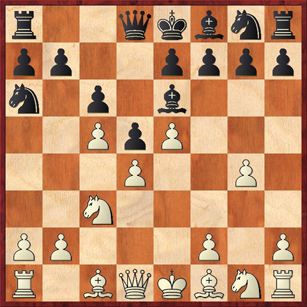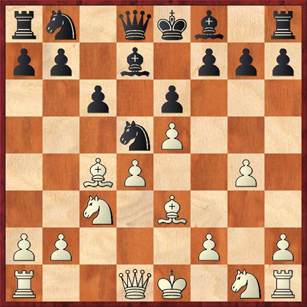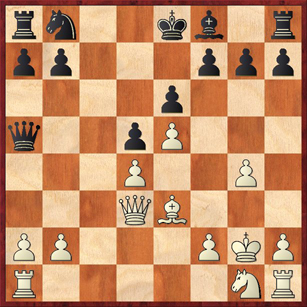All right, let’s talk a little bit more about what happens in Bronstein’s Folly (1. e4 c6 2. d4 d5 3. e5 Bf5 4. g4!?) if Black “chickens out” and plays 4. … Bd7. The reason for this is twofold: first, it came up in a recent US Chess League game, Charbonneau–Enkhbat, which was selected as the “Opening of the Week” by Mark Ginsburg in his blog. Second, I also had a chance to play against 4. … Bd7 in a recent game against GM Larry Kaufman in the U.S. Senior Open. This was quite possibly the worst positional game that I have played this year, so it’s important (at least for me) to understand the reasons for my debacle.
In my third post on Bronstein’s Folly, I recommended two possibilities for White: 5. Nd2, following the last game of the Kramnik-Leko world championship match (except that the moves h4 and … h6 have not been played, which actually works in White’s favor in one critical position from that game) or 5. c4, which was the move that Charbonneau played against Enkhbat. The positional motivation of 5. c4 is rather simple. White wants to force Black to play … e6, which (at least temporarily) locks up the light-squared bishop behind its pawns.
Position after 5. c4.
Here Enkhbat played a creative move that Ginsburg likes but I consider a little bit dubious: 5. … Na6. Obviously, Black is attempting to avoid … e6 and keep the c8-h3 diagonal open. The trouble with this move is that in some lines it gives White the chance to play c4-c5, when Black’s normal response … b6 is (at least temporarily) not available because the knight on a6 would be hanging. If White can actually play c5 and keep the c5-d4-e5 pawn wedge intact (something which in the ordinary course of events he should not be able to get away with), then Black’s bishop on d7 starts looking sicker.
However, I do not think that White can play 6. c5?! right away. Black can play 6. … Qc8!, which both defends the knight (so that … b6 can be played next move) and threatens the loose g-pawn. If 7. Be2, then 7. … b6 is great for Black. The computer recommends 7. Bxa6 ba 8. f3, but I would recoil in horror from this variation, which gives away the two bishops and opens the b-file for Black.
Charbonneau played 6. cd?!, which as Ginsburg points out is also not very good. Black should have replied 6. … Nb4!, when White cannot play 7. dc? because of 7. … Bxc6 8. f3 Qxd4! Black wins back the pawn with this “fork trick” (a very useful trick to know about — I mentioned it in my last ChessLecture) and has a huge advantage. Ginsburg didn’t mention this variation in his notes, presumably because it was too obvious, but sometimes it is worth pointing out the obvious!
So Ginsburg rightly recommends 6. Nc3, a move that furthers White’s development and is also consistent with his plan of pressure on d5. (It’s kind of odd for d5 to be a weak point for Black — in Caro and French positions it almost never is.) If Black plays 6. … e6 now, it is somewhat inconsistent with his previous move, and I think that White can now get away with 7. c5! with an advantage.
Therefore, trying to avoid this passivity, Ginsburg says, “The move 6. … Be6!? is very interesting.” But I think he has forgotten about 7. c5!, which is even stronger here than it is after 6. … e6.
Position after 7. c5.
Let’s think about it logically. In order for White to get away with the space-grabbing 7. c5, Black has to have made a demonstrably inferior move. My contention is that 6. … Be6 is demonstrably inferior (as, indeed, 5. … Na6 may have been). First, Black has wasted a tempo going back to d7 and then to e6. If he wanted to be on e6, why didn’t he go there immediately? Second, on e6 the bishop is potentially in the way of Black’s knight, and it is definitely in the way of the e-pawn. Because the e-pawn is blocked, Black cannot get as much pressure on c5 as he ordinarily would. Now add to this list of complaints the fact that the bishop no longer defends c6, so that after 7. … Qc8 (the move that previously worked against c5) White can now play 8. Be2. Black is still not threatening 8. … b6? because White would answer 9. Qa4, winning material. If 9. … Nc7 10. Qxc6+ — that’s why it was bad for Black to leave c6 undefended.
That’s a pretty long list of sins for one move! Wasting a tempo, getting in the way of two other pieces, and leaving a key square inadequately defended. Black can, of course, play 7. … Nc7 instead of 7. … Qc8, but then White will have no difficulty maintaining his blockading pawn on c5 with 8. b4, for example.
So, all in all, Ginsburg’s 6. … Be6?! doesn’t impress me. If Black wants to continue trying to avoid … e6, maybe he should play 6. … Nc7. But we’ll leave that for another time.
If you want to see the rest of the Charbonneau–Enkhbat game (which was a mess, eventually won by White), you can find it at Ginsburg’s site, reference above, or at the US Chess League website. But let me now proceed to my recent highly unpleasant experience in this variation against GM Kaufman.
From diagram 1 above, Kaufman did not attempt to fight City Hall, and he simply played 5. … e6, a move that is calm and, I think, correct. In fact, throughout this game Kaufman played simple and easy-to-find moves. He probably figured — based on my fourth move! — that I was going to continue playing “creative” moves and shoot myself in the foot, and if so he was correct.
Already my next move was less than perfect: 6. Be3?! The move 6. Nc3, as in the Bronstein–Petrosian game that Ginsburg refers to, makes more sense. The old adage says, “Knights before bishops.” The reason that we have old adages is that they are usually correct. 6. Nc3 is better because it is more flexible. We know that the knight is likely to go to c3, but the bishop has several possible squares it could go to. With 6. Be3 I announce my intentions too soon, and immediately the bishop becomes a target.
Naturally, Kaufman played 6. …dc 7. Bxc4 Ne7 8. Nc3 Nd5, and just as I predicted, the bishop is a target.
Position after 8. … Nd5.
Here I really wanted to play 9. Ne4, but it just seemed as if White’s weaknesses were too profound and his king too exposed after 9. … Nxe3 10. fe Bb4+. If White interposes with the knight, then the move Ne4 loses its purpose. If he moves the king, there is no really safe square to move to.
Having correctly decided against 9. Ne4, I should have settled on the straightforward developing move, 9. Nf3, after which (as they say) “It’s a game.” In particular, White is not too worried about 9. … Nxe3 in this line because his king will castle to safety, his pawn at e3 bolsters the center, and his rook will have a nice semi-open f-file. These factors compensate for the loss of the two bishops.
Instead, being too concerned about preserving the bishops, I played the horrible move 9. Nxd5? This move is awful because (1) it does not develop a piece, (2) it loses a tempo (because White’s c4 bishop will have to move after a recapture), (3) it frees up Black’s light-squared bishop, which White has gone to such lengths to put under lock and key, and (4) the bishop that White is laboring to preserve (the bishop on e3) will turn out to be a bad bishop and not worth saving! Earlier in this post I wrote about a move committing a lot of sins. Well, this one is even worse.
It really galls me that I played this move, because I have studied Jeremy Silman’s books, I understand about imbalances, and even given a ChessLecture on them, but nevertheless in a position that boils down to a simple evaluation of imbalances I failed to apply my knowledge. I think the reason is that I was so determined to think about the position tactically that I fixated on the “threat” of … Nxe3 and did not even attempt to reason about the position strategically.
In Russian there is a nice phrase, “iz ruk von ploho,” which roughly means that something is so bad that you just want to wash your hands of the whole thing. That’s the way I feel about 9. Nxd5.
But my sins were not over! After this the game continued 9. … cd 10. Bd3 Qa5+ 11. Kf1 (probably a mistake too, but I’m still busy being “creative”) 11. … Bb5 (The crux of the position. Black can exchange his bad bishop, but White can’t exchange his.) 12. Kg2 Bxd3 13. Qxd3 and now Black played a very simple, principled move.
Position after 13. Qxd3.
Here Kaufman played 13. … Qa6!, offering an exchange of queens. This is a very interesting moment because, if you go over the game with a computer (at least with my copy of Fritz 9), it actually considers this a blunder that gives away virtually Black’s whole advantage. This shows once again why you should always look at computer analysis with a skeptical eye.
But it’s not just computers. I know a lot of humans who would never play a move like 13. … Qa6 because they “don’t like to trade queens,” they “like to play attacking chess,” etc. This move shows how you can use the threat to trade queens as a weapon. What Black wants to do is suck all the life out of White’s position. White’s queen is his only active piece — once it is exchanged, all White will be able to do is defend passively, and try to keep sticking his thumb in all the leaks that will appear in his position. Kaufman is announcing that White’s position is so bad, already, that Black can go straight into an endgame and win.
To be honest, I didn’t quite believe it myself, and so I took Kaufman up on his offer and played 14. Qxa6?! Nxa6. Probably, in retrospect, I should have kept the queens on. Again, it’s a matter of imbalances. I want to keep my best piece on the board, so I should play 14. Qc2, which is a great square for the queen, eyeing c7 and h7. I should only consent to a queen trade if Black plays 14. … Qc4? (which I’m sure Kaufman would not do), because now 15. Qxc4 cd 16. Rc1 b5 17. b3 (or even just 17. Ne2) creates imbalances in White’s favor — an open c-file, possibly penetration to the seventh rank with the rook, and a potentially dangerous pawn break with d5, after which the bad bishop will no longer be bad any more.
I’ll skip the rest of the game, but if you want to see how Kaufman finished it off you can get the PGN here. Basically, I tried to solve my positional problems tactically, which seldom works and did not work in this game. To make things worse, I got into time pressure and fell into an obvious “fork trick”.
Bad as my play was, I think this was a good lesson in not trying to force tactics on an inherently strategic postion. It was also a very good lesson in exchanges. When you’re starting out in chess, there is a tendency to think that “fair trades” like 9. Nxd5? and 14. Qxa6? do not affect the position much, because they keep the material balance. And even for more experienced players, there is sometimes a tendency to be more willing to trade pieces against a higher-rated opponent. We delude ourselves into thinking that this gets us closer to a draw.Â
In reality, there are lots of imbalances that can be affected by trades, and an apparently “fair trade” can actually be a very bad deal … especially against a higher-rated opponent! Learning how to exchange pieces properly — when to offer an exchange, when to avoid an exchange, when to accept your opponent’s offer and when to decline it — is a very big part of mastering chess.







{ 4 comments… read them below or add one }
Chess Wit and Wisdom
There is no try. There is only do or not do. — Mrs. Kim, fictional character on “Gilmore Girls”
You must know by now that was Yoda.
I just wrote an email called the Antaeus Principle at BrianWallChess.net which means trading down against a higher rated player often fails because their understanding approaches infinite perfection if the position is simple enough. 2008 US Junior Champ Tyler Hughes agreed with me, stating – I keep it simple against lower rated players and complex against higher rated players.
Hi Brian,
Yes, someone else pointed that out, too. When I heard this on “Gilmore Girls” I thought it was probably a Yoda reference, but when I got on the Internet and tried to find the exact words from Yoda I didn’t come up with a match. Can someone tell me if these were Yoda’s exact words, or is this only a paraphrase of something he said? (Not being a huge “Star Wars” fan, I don’t have the entire dialogue committed to memory.)
If you wrote an opening book, I’d buy it.
I’d buy it too… 🙂